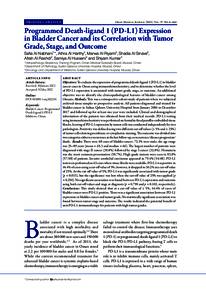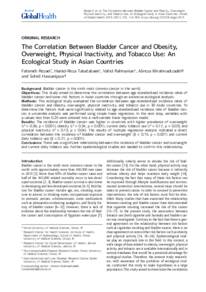وثيقة
Programmed death-ligand 1 (PD-L1) expression in bladder cancer and its correlation with tumor grade, stage, and outcome.
المعرف
DOI 10.5001/omj.2022.96
المساهمون
Al-Harthyiah, Athra., مؤلف
Al-Riyamiyah, Marwa., مؤلف
Al-Sinawiyah, Shadia., مؤلف
Al-Rashdiyah, Afrah., مؤلف
الناشر
Oman Medical Specialty Board.
ميلادي
2022-11
اللغة
الأنجليزية
الموضوع
الملخص الإنجليزي
Objectives: To evaluate the expression of programmed death-ligand 1 (PD-L1) in bladder
cancer cases in Oman using immunohistochemistry, and to determine whether the level
of PD-L1 expression is associated with tumor grade, stage, or outcome. An additional
objective was to identify the clinicopathological features of bladder cancer among
Omanis. Methods: This was a retrospective cohort study of patients where we subjected
archived tissue samples to prospective analysis. All patients diagnosed and treated for
bladder cancer in Sultan Qaboos University Hospital from January 2006 to December
2017 and followed up for at least one year were included. Clinical and demographical
information of the patients was obtained from their medical records. PD-L1 testing
using immunohistochemistry was performed on formalin-fixed paraffin-embedded tissue
blocks. Scoring of PD-L1 expression by tumor cells was conducted independently by two
pathologists. Positivity was defined using two different cut-off values (≥ 5% and ≥ 25%)
of tumor cells showing membrane or cytoplasmic staining. The outcome was divided into
two categories either no recurrence at the last follow-up, or recurrence/disease progression/
death. Results: There were 68 cases of bladder cancer; 72.1% were male; the age range
was 35–89 years (mean = 65.3 and median = 66). The largest number of patients were
diagnosed with stage II cancer (38.8%) followed by stage I cancer (32.8%). Hematuria
was the most common presentation (58.7%). High-grade tumors were seen in 83.8%
(57/68) of patients. Invasive urothelial carcinoma appeared in 79.4% (54/68). PD-L1
tests were performed on 63 cases where tissue blocks were available. PD-L1 was positive in
44.4% of cases using a cut-off value of 5%; however, it dropped to 30.2% at a cut-off value
of 25%. At the cut-off value of 5%, PD-L1 was significantly associated with tumor grade
(p = 0.033), but the significance was lost when the cut-off value of 25% was applied (p
= 0.250). No significant association was found between PD-L1 expression and outcome
using both cut-off values and stage at diagnosis (p = 0.798 and p = 0.102, respectively).
Conclusions: This study showed that at a cut-off value of ≥ 5%, 44.4% of cases of
bladder cancer were PD-L1 positive. There was a significant association between PD-L1
expression in bladder cancer and tumor grade. No statistically significant association was
found between tumor stage and outcome. The results indicated the potential benefit of
anti-PD-L1 immunotherapy for patients with high tumor grades.
المجموعة
URL المصدر
zcustom_txt_2
Al-Nabhaniyah, Safia, Al-Harthyiah, Athra, Al-Riyamiyah, Marwa, Al-Sinawiyah, Shadia, Al-Rashdiyah, Afrah, Al-Husseniyah, Samiya, & Kumar, Shiyam (2022). Programmed death-ligand 1 (PD-L1) expression in bladder cancer and its correlation with tumor grade,
قالب العنصر
مقالات الدوريات


